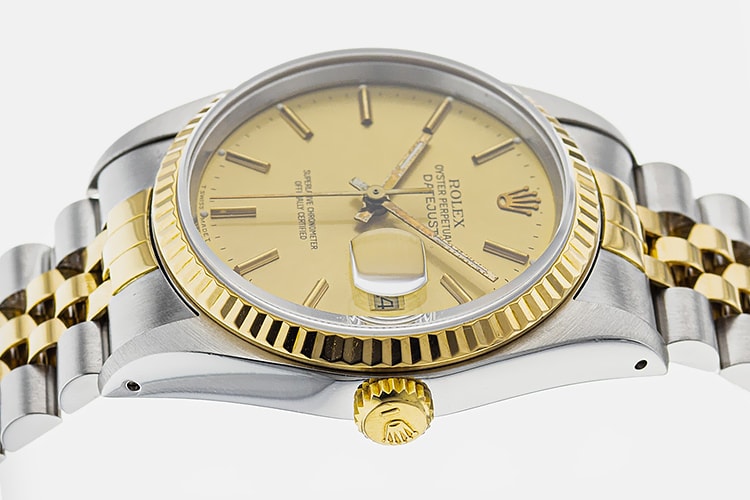Watch Terminology Glossary

A guide to watch features you need to know when shopping for a fine watch
This Watch Glossary of the terminology for the main functions and features of watches was developed by Jewelers of America in collaboration with the experts at WatchTime, America’s leading watch magazine.
Alarms
Ability to schedule the watch to alert you with an alarm sound at a pre-set time.
Analog Display
Time is displayed by hands rotating on a marked dial.
Automatic or Self-winding
Mechanical timepieces that are wound by the motion of the wrist. This motion makes the rotor pivot around a staff connected to the mainspring through a gearing. Overwinding is prevented by a clutch.
Bezel
The ring that surrounds the watch face. This holds the glass covering or crystal in place. It can be stationary or rotating or have special functions, like indicating minutes on a diving watch.
Chronograph
A stopwatch that measures continuous or discontinuous intervals of time. The chronograph can be started, stopped and reset at will by way of push buttons. When used in conjunction with specialized scales on the watch face, it can perform many different functions, such as those of a tachometer, a telemeter or a pulsimeter. Not to be confused with a chronometer.
Chronometer
A chronometer is a movement that has received a certificate delivered after passing a series of stringent tests under varied temperatures, vertical positions, etc. The most renowned official testing organism for chronometers is the Swiss C.O.S.C., or Contrôle Officiel Suisse des Chronomètres.
Date Display
Usually a calendar, this feature shows the date. There are several types of watch date displays: digital or sub-dial calendars. A “perpetual calendar” automatically adjusts for the varying lengths of months (28, 29, 30 and 31 days) and for leap years.
Digital Watch
A watch that displays the time through numerals, usually using LCD or LED technology, rather than with a dial and hands (analog) display.
Escapement
A device in a mechanical watch that controls the rotation of the wheels and the motion of the hands.
Fly-back Function
An extra second-hand that is superposed on a chronograph’s main second-hand and is commanded by an additional push-button. To read intermediate time duration, the fly-back hand is stopped, and then made to “fly back” to rejoin the main second-hand.
Guilloché
On the face of the watch, an engraving technique in which a very precise, intricate, repetitive pattern or design is mechanically etched into an underlying material with very fine detail.
Index
A design used to mark a period of time on a dial, usually the hours, the minutes and the seconds. Markers can also be used to indicate the remaining hours on a power reserve indicator, the heartbeats on a pulsimeter, etc.
Jewels
Synthetic rubies or sapphires used as bearings in a watch movement to reduce friction between parts. They also have the capacity to retain lubricants by capillary action, releasing them little by little. Many mechanical watches have 17 of them, although their number can go up to more that 60 on collectors’ masterpieces.
Moon-phase Indicator
A disk with a drawing of the moon rotating underneath the dial according to the rotations of the moon. The phases can be seen through a “guichet,” or window, and are sometimes accompanied by the indications of the age of the moon.
Multiple Time Zones
A watch that simultaneously displays time in multiple cities, either with separate hour hands or apertures. Other terms associated with this complication are “Dual Time Zone” and “World Time.”
Mechanical Movement
A movement powered by a mainspring and a balance wheel, as opposed to a quartz movement, which requires a battery. Some mechanical movements are automatic (or self-winding), where the mechanical timepiece is wound by motion of the wrist.
Perpetual Calendar
A calendar that automatically adjusts for the varying lengths of months (28, 29, 30 and 31 days) and for leap years.
Quartz Movement
A movement powered by a quartz crystal and battery. This synthetic crystal oscillates 32,768 times per second.
Sapphire Crystal
A transparent, shock-resistant, scratchproof, synthetic-sapphire covering used to protect the face of a watch.
Shock Resistance
As defined by U.S. government regulation, a watch’s ability to withstand an impact equal to that of being dropped onto a wooden floor from a height of three feet.
Tourbillon
The tourbillon corrects errors in timekeeping due to the effect of gravity on a watch in vertical positions: in a regular escapement/balance mechanism, the center of gravity shifts, depending on the position of the watch in space (horizontal, vertical), thus affecting its rate.
Tachometer/Tachymeter
A scale, usually located on or near the bezel of a watch, that measures the speed at which the wearer has traveled over a measured distance.
Water Resistance
A watch’s ability to withstand water pressure to a stated depth. Watches marked as “water resistant” without a depth indication are designed to withstand splashes of water only. Watches with high levels of water resistance will reflect this by stating the number of meters the watch is resistant to (usually between 50-200 meters).
Source: WatchTime.com